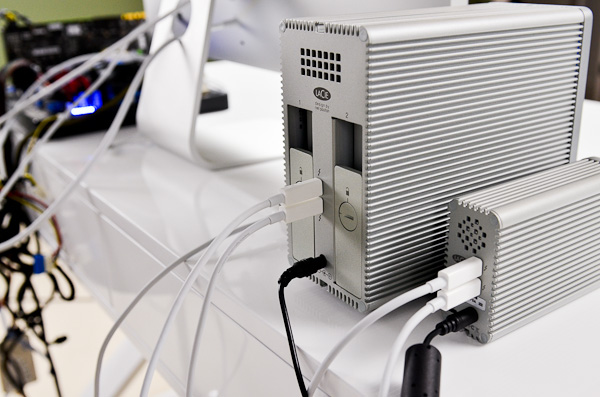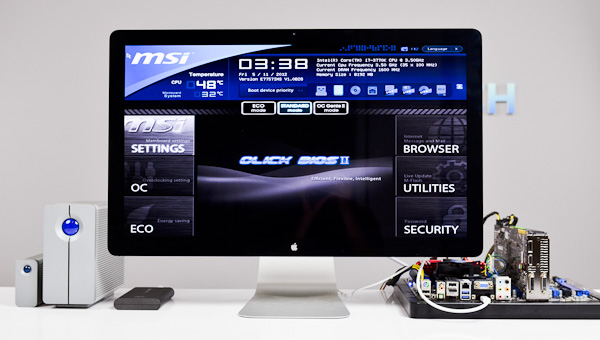A First Look at Thunderbolt on Windows with MSI's Z77A-GD80
by Anand Lal Shimpi on May 11, 2012 1:32 PM EST- Posted in
- Motherboards
- CPUs
- Intel
- MSI
- Thunderbolt
The Storage Devices & Performance
Other than Apple's Thunderbolt Display, every other TB device we've tested has been some sort of storage device. In my lab I've got Promise's Pegasus R6, LaCie's 2big and Little Big Disk (SSD), Seagate's GoFlex Thunderbolt adapter and Elgato's Thunderbolt SSD. With the exception of the Pegasus R6, which currently lacks Windows drivers, all of the storage devices I tested worked with MSI's Z77A-GD80 under Windows. Although there are workarounds for getting the Pegasus up and running under Windows, I encountered a number of hangs and general system unhappiness whenever I tried them on this platform. I suspect this has something to do with why Promise has yet to officially release Windows drivers for the Pegasus.
The rest of the storage devices, as you would expect, just worked. I didn't need to install any drivers as all of their internal controllers had native support under Windows 7. Again, I couldn't hot plug any of these devices once Windows was running - all of them had to be present at boot.
Just as I've seen under OS X, with complex Thunderbolt chains you'll sometimes have a device that hangs in the chain and prevents some or all TB devices from working. I did encounter this behavior more frequently under Windows than I did under OS X. Keep in mind that every single Thunderbolt device on the market today was pretty much developed and tested against Macs, it's going to be a little while before we get perfect behavior under Windows. We don't even have perfect behavior under OS X yet either. My hope is that as more platforms ship with Thunderbolt support, and as we get more Thunderbolt devices, compatibility and behavior validation will both improve. I've also heard that the early Thunderbolt controllers were more finicky than Cactus Ridge, so it's possible that newer TB devices that come out this year will just inherently be better behaved. This is purely hearsay however, I don't have any hard evidence to back it up.
Update: Intel tells us that an updated Pegasus driver is in the works that will address the issues we've seen. Other finicky behavior is also expected to be addressed through the Thunderbolt on Windows certification process.
Since I couldn't get the Pegasus working, I had to resort to combining a bunch of my other Thunderbolt storage devices to measure performance. I created a chain combining LaCie's 2big, the SSD Little Big Disk and Elgato's Thunderbolt SSD along with Apple's Thunderbolt Display. I ran a 128KB sequential read test at a queue depth of 32 across all of the drives, while pushing the Thunderbolt Display at its native 2560 x 1440 resolution:
The best I ever got under OS X was 8Gbps using four SandForce SSDs in the Promise Pegasus. At 7Gbps using a far less elegant setup, this isn't bad at all. Keep in mind that while we're reading at 7Gbps, the GD80 was also using around 7Gbps of bandwidth to drive the Thunderbolt Display at 2560 x 1440. Total available bandwidth for a single-port Thunderbolt device is 20Gbps bi-directional (40Gbps total), so there's still additional headroom available.
Moving Forward
MSI's Z77A-GD80 finally brings Thunderbolt to Windows desktops. With a few exceptions, the experience is quite similar to OS X. The major differences are that some devices clearly need more compatibility testing with these new platforms, and that you can't hot plug Thunderbolt devices under Windows. The former is solvable given additional time, while the latter can be more annoying in the long run if a workaround isn't found. For a single, high-speed storage device under Windows, USB 3.0 is going to be the simplest route. It's only when you want to start pushing even more bandwidth and/or add a display into the mix that Thunderbolt becomes your only solution.
Thunderbolt's functionality otherwise looks very similar under Windows as it does under OS X. The interface doesn't require any specific drivers and in the best conditions it just works. Thunderbolt's behavior remains quite finicky however, even more so under Windows. You'll want to wait for either the next generation of Thunderbolt devices or for the current device vendors to get some more time validating their Thunderbolt products on Windows platforms. Given that the first Thunderbolt equipped PC motherboards haven't even shipped yet, you've got some time.
Update: Intel has informed us that we will see updated drivers for Windows certified Thunderbolt devices that will enable hot plugging under Windows. Intel further informed us that MSI's board has not yet made it through the certification process and a lot of these teething issues will hopefully be addressed by then.
For much of the past year I've been calling for cheaper Thunderbolt storage devices, but with the arrival of Thunderbolt on Windows I'll modify my plea: we need more Thunderbolt display devices as well. As the desktop PC evolves, it would be nice to have only a single cable running from your PC to a Thunderbolt equipped display that acts as the IO hub for all of your peripherals. I'm thinking of something like Apple's Thunderbolt Display, but even heavier on the expansion side and with OS-independent display controls.













98 Comments
View All Comments
ananduser - Friday, May 11, 2012 - link
I recall MS stating that TB will never be supported by them due to security issues. TB support will have to be provided by 3rd parties.A5 - Friday, May 11, 2012 - link
And the article pretty clearly states that TB is transparent to the OS because it is just a bunch of PCIe lanes. MS doesn't really need to do anything to enhance support.embeddedbill - Friday, May 11, 2012 - link
The security issues have nothing to do with 3rd party support. Pcie in every other instance was an internal device, now via TB, someone can develop a piece of hardware that has nefarious firmware and gain system level access - without opening up the computer.DerPuppy - Saturday, May 12, 2012 - link
pretty much: see firewire. direct memory access "issues" i guess. but if someone has physical access to your computer you're screwed anyways.ka_ - Friday, June 1, 2012 - link
"pretty much: see firewire. direct memory access "issues" i guess. but if someone has physical access to your computer you're screwed anyways. "I must say I disagree to this to a large extent even though I would agree if we add: Physical access without anyone else present.
It is something entirely different to require someone to force power offs, use screw drivers, or do some other highly unusual things to a machine than simply plug it to a display or NAS or something with two tb connectors and hack it from the machine connected on the other side. That or a device with chained TB connectors i.e. projector sharing the connection with a Trojan device.
Expect to see something like this on a security conference soon... "We tested this projector on all the presenters machines and..."
embeddedbill - Friday, May 11, 2012 - link
Microsoft will also have an aversion to anything that allows you to boot using Windows on an external disk. Pcie is a threat to that because they might feel some loss of control.dagamer34 - Saturday, May 12, 2012 - link
Em... Windows 8 To Go allows you to boot a full version of Windows from a USB stick.Conficio - Friday, May 11, 2012 - link
And why again would I pay top dollars (for the mother board, the peripheral and the cables to connect those) to put the storage outside of my full size desktop? I don't see the use case.If it would be a nice small form factor running silently and still is expandable through thunderbolt, that would make sense.
Or if I can access the storage and the display in my desktop through thunderbold from my laptop (and auto backup/sync/drop box) that would make sense as well. The standby desktop becoming the hub, sounds feasible to me as the interface is symmetrical.
By the way w/o hot plugging this is broken. As you report those issue on Mac OS X as well, I'll go and wait until this becomes stable.
embeddedbill - Friday, May 11, 2012 - link
The most compelling use cases will be in the mobile market for sure. However for someone who covets the bandwidth for frivolous stuff, I can see this in a niche.ggathagan - Friday, May 11, 2012 - link
Given the ability to daisy chain up to six devices, this could represent an awful lot of storage capacity.From the manufacturer's standpoint, I think it makes a lot of sense for MSI to use ATX for their 1st motherboard with TB.
ATX has lot more real estate to work with when deciding how to design the motherboard.
It's also their flagship Z77 motherboard, with all the bells-and-whistles.
At the price point of their flagship board, it helps recoup R&D costs.
Given the scarcity of TB devices at this point in time, I doubt anyone wants to dive in.
I expect more of a "sticking-my-toes-in-the-water approach from board makers.
Once there are more devices made to utilize TB, I think you'll see a more widespread adoption of TB.
As others have pointed out, TB has a better fit in the mobile market at this point.